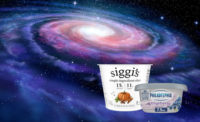Yogurt standard of identity goes under the microscope
Products may not meet new FDA standards; what you need to know

Photo courtesy of alexkich via www.gettyimages.com

The yogurt standard is a topic that has generated a lot of discussion over the years in the industry with little response from the Food and Drug Association (FDA) until recently. For those of you who may be new to the yogurt regulatory world, the Standard of Identity (SOI) for yogurt was established in 1981. It is listed in the Code of Federal Regulations as 21CFR 131.200 (eCFR :: 21 CFR 131.200 -- Yogurt.). Many dairy products have federal standards based on composition, manufacturing, and quality requirements. Meeting the yogurt standard allows a product to use the term “yogurt” on the label.
Standards are meant to protect the nutritional properties and quality of a food product, so consumers are ensured that the product hasn’t been compromised using processes or ingredients that have a negative impact on those properties. Fortunately, the United States has the International Dairy Foods Association (IDFA), who speaks for the yogurt manufacturers and works on their behalf with the FDA to request changes to the yogurt standard. IDFA has done a great job of communicating their interactions with the FDA, keeping its constituencies up-to-date on the timeline of events through the years.
The purpose of this article is not to reiterate the history of those interactions. You may ask why changes would need to be made to a standard? Since the standard was created 40 years ago, there have been many new ingredients and processes developed that have created a lot of new and innovative products. While most of these ingredients and processes have improved the nutritional properties and quality of yogurt, many of these innovations simply were not part of the original standard.
Trends and innovations
Allowable ingredients have always been a part of the standard. The use of whey protein concentrate (WPC) has been allowed in yogurt, but it needed to be Grade A WPC because yogurt is a Grade A product. Until the last decade, it wasn’t always easy to find a Grade A WPC, so that limited its use in yogurt.
Remember the “low carb” trend from 2004 to 2005? Any yogurt that was developed and labeled as “low carb” because it used artificial sweeteners, sugar alcohols or ultrafiltered milk could not legally use the term “yogurt” on the label, Instead, it had to be labeled as a “cultured product.” Prior to the “low-carb” days, most yogurts were focused on having low levels of fat. However, there were separate standards for low-fat and fat-free yogurts to allow for lower levels of fat. Many of these same yogurts were loaded with sugar, so it was difficult to say that they were more nutritionally superior just because they met the standard.
Increasing protein
The low-carb days created more focus on protein and by 2007, the U.S. was seeing the first Greek yogurts showing up on the market. These first products were strained using a Quark separator, which was common in Europe but new to America. There is no Greek yogurt standard. Yet, this type of yogurt also needed to meet the yogurt standard in order to use the term “yogurt” on the label. High-protein yogurts soon followed that were formulated with milk protein concentrates/isolates and whey protein concentrates. These also were labeled as Greek yogurt.
Of course, the companies using the straining method voiced their concerns about the fortified products, but no action was taken because a Greek yogurt standard of identity (SOI) didn’t exist. In the past decade, ultrafiltered (UF) milk has been more commonly used as the starting point to produce high-protein yogurt. Today’s Greek yogurts in refrigerated dairy cases now are using straining methods, UF milk, and adding dairy proteins which are formulated using the same protein, carbohydrate, and fat content. Greek yogurts and the high-protein yogurt category in general have exponentially increased the size of the yogurt market more so than any past dairy innovations.
Adding fat
Higher fat yogurts are much more prevalent now that milkfat has a better reputation from a nutritional standpoint — plus it improves the flavor and texture of yogurt. Since these yogurts were introduced to the U.S. market, it’s been a standard industry practice for strained yogurts to add pasteurized cream to the yogurt after culturing/fermentation. That is the only feasible method to manufacture strained yogurt with higher fat content. There have been no safety issues as a result, and these higher-fat Greek yogurts are well-liked by consumers. Today, the trends are also focusing on lower sugar and low/no added sugar. Using ultrafiltration is a great tool for lowering the lactose content in milk and thus lowering the sugar content in yogurt. Hydrolyzing the lactose by adding lactase also increases the sweetness of the yogurt without adding sugar.
The final FDA decision
All of these technologies have helped to provide innovation and some great new products to the yogurt category. The real question is — has the yogurt standard changed to include the use of these manufacturing techniques and ingredient technologies? The final ruling by the FDA, submitted on December 14, 2022, denied any requests for a public hearing and modified the final rule in response to certain objections. FDA has rejected IDFA’s request to allow the addition of pasteurized cream after culturing/fermentation and the use of UF milk as an ingredient.
The requests that were granted, and included in the final standard, allow the use of all safe and suitable sweeteners, including non-nutritive sweeteners; set the minimum, optional fortification of vitamin D at 10% of the Daily Value; permit the use of fat-containing flavoring ingredients (such as coconut flakes, chocolate, etc.) in lower fat yogurt that increase the total fat above the nutrient content claim level related to milkfat content; and permit the manufacture of yogurt with milkfat content less than 3.25% but at least 2.44%. These rules became effective on Jan. 17, 2023, and cultured dairy processors have until January 1, 2024, to comply.
Yogurt is just one example where the standards are not keeping up with innovation. For those companies that are wondering what to do because their yogurt suddenly doesn’t meet the new SOI, IDFA is the organization that can help.
Looking for a reprint of this article?
From high-res PDFs to custom plaques, order your copy today!






